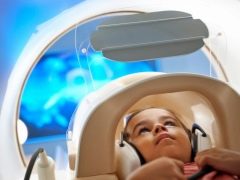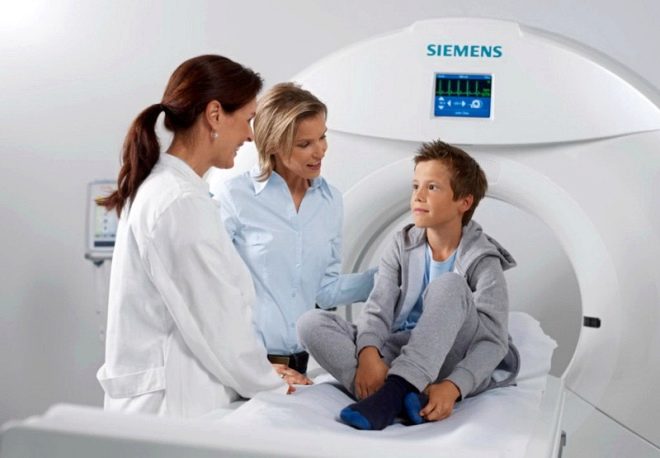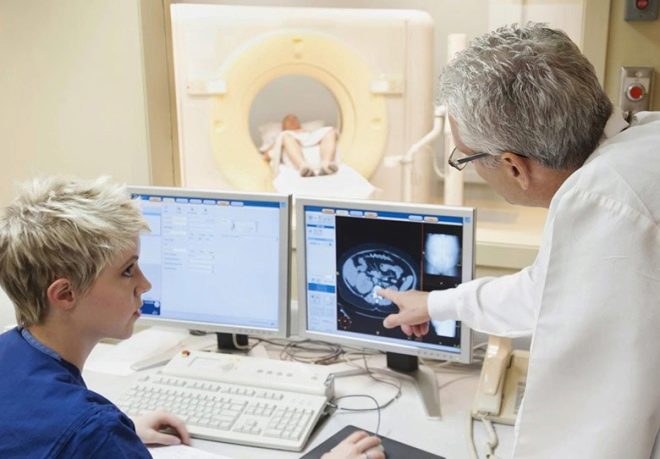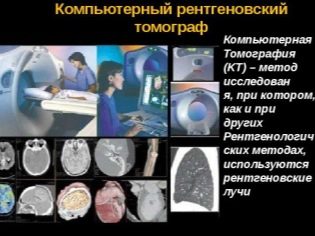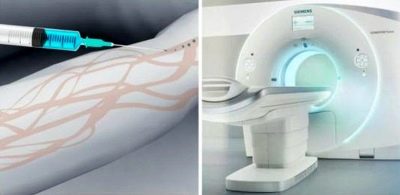Types and features of computed tomography for children
Modern medical diagnostics has many ways to determine the cause of a children's illness when it cannot be visually done. A peek inside the body, to assess the processes occurring there, allow high-precision diagnostic methods, which include computed tomography - CT. What types of CT do children do, how is the diagnosis and what are its features, we will tell in this article.
About the method
CT scan will never be prescribed to a child unless absolutely necessary. Already because the examination includes the effect on the children's organism by X-rays, to which the babies are known to be several times more sensitive than adults.
If parents receive a referral for computed tomography from the doctor, there is no doubt that the medical specialist weighed all the pros and cons and came to the conclusion that the lack of diagnosis for the child is more dangerous than exposure to radioactive radiation.
Such rays with different intensity are reflected from the tissues of the body. It is this property that makes it possible to create not just a detailed picture of a certain organ, but also to obtain its layer-by-layer image, in which pathological changes cannot remain unnoticed. The CT method was invented in 1972, for which its authors were recognized by Nobel laureates.
Moms are often confused with MRI and CT. The difference is fundamental. MRI is based on exposure to electromagnetic rays, and CT is based on exposure to x-rays. Children who need as accurate a diagnosis as possible are usually prescribed CT, since this method of obtaining information on the state of the internal organs is considered to be much more accurate than MRI.
Computed tomography provides a valuable opportunity to identify the disease at the very initial stage, which is of great importance for treatment and prognosis for the future. Types of CT are divided by the studied organs and systems. Most often, an examination is prescribed for the occasion of cranial injuries, but there is also a need to do a CT scan in case of suspicion of pathologies of other internal organs - lungs, kidneys, liver, heart, as well as suspicion of abnormal processes in the locomotor system or vessels.
Types of research
Depending on how many slices will be examined for one circular rotation of the tomograph tube, single-section and multi-section CT are distinguished. Also, the procedure may require the use of a contrast agent, and may be carried out without contrast. For example, for brain CT, a contrast agent is injected intravenously to better visualize possible problems. And to diagnose the pathologies of certain organs of the abdominal cavity, it needs to be drunk.
According to the number of revolutions of the tube, sequential, spiral, and multilayer multislice tomography are distinguished. Different methods differ in their technical characteristics, speed of the apparatus, methods of obtaining the image, returning the tube to its original position. This information may be of interest to professional physicists or physicians, but it is completely useless for parents.
Indications
The reason for the appointment of CT baby can be a variety of symptoms. CT scan of the brain is prescribed for suspected abnormalities in the development of the baby, for suspected neoplasms, traumatic lesions, hemorrhage.Often, this procedure has to be resorted to in the first days after the birth of the baby, if he was born prematurely and there are signs of juvenile stroke, if the child has experienced severe acute hypoxia during birth.
The results of CT in two projections will help the doctor better understand which parts of the brain are affected, how deep and serious the damage is. This is extremely important for choosing a method of further treatment.
The infant may require CT scan of the brain, as well as the temporal and other cranial bones after a fall, and a head impact. Computed tomography of the chest is assigned less frequently, only in cases of suspected severe congenital anomalies of the heart and lungs. The method is considered preferable because the lungs filled with air are best visualized.
MRI may be more suitable for examining the maxillary sinuses and larynx, but computed tomography may also be recommended, especially in cases where the doctor suspects a child with tumors.
Features of the children
During the examination on the tomograph, the child must for a sufficiently long time maintain relative or complete immobility on the tomograph table. It is clear that to demand this from the kids is impossible. Therefore, for infants and younger children, computed tomography is performed under anesthesia.
Before proceeding with the examination, the anesthesiologist weighs the child and injects the required dose of the drug, which will ensure a quiet and sufficiently long medication sleep.
Older children CT can be done as adults - without anesthesia, provided that the child does not get scared of the scanner, he will not get hysterical: after all, it will take 15-20 minutes to be inside the scanner.
From what age?
It is possible to do computed tomography for children of any age - both newborn, and small, and adolescents. A prerequisite - the presence of specific recommendations of the doctor for the examination procedure.
If in a particular case there is an alternative, believe me, the doctor will definitely use it. For example, newborns have the opportunity to examine the brain using neurosonography (ultrasound through a spring), and at the age of 2-3 years, when the spring is closed and hardened, alas, there is practically no alternative.
MRI has its contraindications, for example, the presence of metal parts or implants in the body, and therefore the method is not suitable for everyone. In this case, CT is also recommended.
Training
If computed tomography is prescribed to the child, parents should know how to prepare the child for the upcoming procedure.
- It is not recommended to feed and water the baby before the procedure for 4 hours. This will make it easier for him to transfer funds that are used for immersion in drug sleep.
- An older child who is able to undergo an examination without anesthesia is prepared psychologically, talking about what lies ahead, how it will be. You can show the children of the CT scan to the child, tell you that the tomograph is actually a spacecraft, and he himself will have to be for a short time the most real star traveler.
- For a child of any age, a preliminary examination is required. Before heading to CT, you need to get a pediatrician's conclusion in your hands, an electrocardiogram and general laboratory tests of blood and urine.
- If CT is suggested with contrast, it is necessary to obtain a conclusion from an allergic specialist confirming that the child is not allergic to iodine, since it is part of the contrast solution.
It is clear that such measures can not be taken if CT scan is performed on an emergency child for life reasons, for example, after receiving a severe brain injury when the clock goes on. In this case, doctors conduct rapid testing for allergy to iodine and immediately proceed to the diagnosis.
Is it harmful?
The results of CT are highly valued by doctors of various specialties, regardless of the country in which the survey was conducted. The advantage of the method lies in obtaining very high resolution images, in which even minimal deviations from the norms are clearly and layer-by-layer visible. There is also an opportunity to make a three-dimensional model of a diseased organ, which is very important for correct diagnosis in particularly difficult cases.
The examination is painless, it is not felt by a child who undergoes a CT scan without anesthesia. For this you can not worry. But practice shows that parents are experiencing basically and not for it, but for the possible harm and consequences of exposure to x-rays in the future. Is CT dangerous? To a certain extent, it is dangerous, but no more than with conventional X-ray, because the radiation dose during X-ray passage is higher.
Doctors use significantly smaller doses of radiation to diagnose children, but the fact of using X-rays X-rays, alas, does not allow us to speak about the safety of this method.
Professional medical literature describes the increased risk of developing cancer in the future in children who have undergone several CT procedures. However, these data were based on the statistics of the 90s, while radiation doses were incomparably higher than modern ones.
Experienced radiologists argue that the harm from computed tomography is much lower than the refusal of such an examination, which can lead to a lack of accurate and timely diagnosis and death of the child or irreversible consequences for his health due to unrecognized disease.
Thus, experts cite the following fact: people receive a dose within 3 mSv daily - from sunlight, radiation of terrestrial rocks and from isotopes in food. And just such a dose is enough to conduct a CT scan of the child.
The risk of developing cancer after CT scan is estimated by radiologists at 1: 4000, which means that only one in four thousand children will have an increased chance of oncological consequences. Usually these are children with hereditary predisposition. Thus, the danger of research in the popular sense is greatly exaggerated.
Nevertheless, there are WHO recommendations that children should not have a CT scan more than twice a year. After each examination, you should give your child to drink plenty of fluids and walk more with him in the fresh air, avoiding exposure to direct sunlight. So the radiation will be output faster.
Reviews
Despite all the arguments of evidence-based medicine and a clear rationale of the attending physician about the prevalence of benefits over harm, most parents express extreme concern about the upcoming procedure and are even ready to refuse diagnostics in order not to expose the child to danger.
Not less radiation moms scared and the prospect of general anesthesia, especially since the Internet is enough reviews that the child felt bad after the procedure. The issue of tolerance of anesthesia is individual, it depends on the age, state of health and qualification of the anesthesiologist. Therefore, there is no reason to compare the health of your child and the other.
Being in the closed capsule of the appropriate type of tomograph is also undesirable for children with increased nervous excitability, impressionable babies. Therefore, it is best to choose a medical statement in which new ones are installed tomographs open type, in which the child will not be limited to the walls of the capsule. On such equipment, children feel better and calmer.
How to prepare the child for computed tomography, see the following video.
